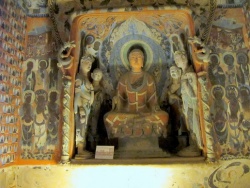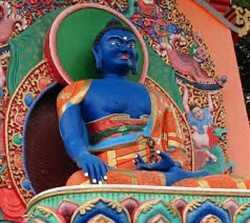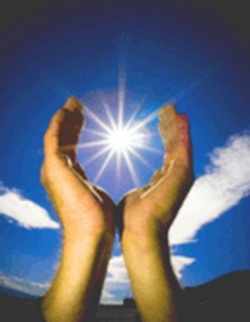Difference between revisions of "The Kagyu lineage"
| Line 27: | Line 27: | ||
[[Kunga Nyingpo]] had received the entire [[Lam Dre]] [[teaching]] from his [[guru]], but after an attack of [[food]] poisoning he found he had forgotten the instructions. As these special teachings were only passed on orally, and there was no one with whom he had direct [[contact]] who could repeat them to him, his situation was very difficult. In response to this crisis he [[meditated]] one-pointedly, invoking his [[guru]], and was rewarded with a [[vision]] of [[Virupa]], surrounded by four of his [[disciples]], his dark brown [[body]] shining like a hundred thousand suns. [[Virupa]] gave him the complete [[teaching]]. Applying himself to [[meditation]] on [[Hevajra]], [[Kunga Nyingpo]] came to {{Wiki|equal}} the great [[Indian]] [[Tantric]] [[masters]] in his [[spiritual]] [[realization]]. | [[Kunga Nyingpo]] had received the entire [[Lam Dre]] [[teaching]] from his [[guru]], but after an attack of [[food]] poisoning he found he had forgotten the instructions. As these special teachings were only passed on orally, and there was no one with whom he had direct [[contact]] who could repeat them to him, his situation was very difficult. In response to this crisis he [[meditated]] one-pointedly, invoking his [[guru]], and was rewarded with a [[vision]] of [[Virupa]], surrounded by four of his [[disciples]], his dark brown [[body]] shining like a hundred thousand suns. [[Virupa]] gave him the complete [[teaching]]. Applying himself to [[meditation]] on [[Hevajra]], [[Kunga Nyingpo]] came to {{Wiki|equal}} the great [[Indian]] [[Tantric]] [[masters]] in his [[spiritual]] [[realization]]. | ||
| − | The second of the five [[masters]] was [[Kunga Nyingpo's]] son, [[Sonam Tsemo]] (1142-1182), who did much work in systematizing the [[Tantric]] {{Wiki|literature}}. He was directly inspired by [[Avalokitesvara]]. The third of the five is his younger brother [[Drakpa Gyaltsen]] (1147-1216), a renowned [[scholar]] and [[yogin]], who is said to have been continuously helped by the [[Bodhisattva Manjusri]]. [[Sakya Pandita]] (1182-1251), grandson of [[Kunga Nyingpo]], is the fourth of these great [[gurus]]. He is considered an [[emanation]] of [[Manjusri]]. He was responsible for the full assimilation into [[Tibet]] of the system of [[logical]] analysis of the [[Indian]] [[master]] [[Dharmakirti]], and in | + | The second of the five [[masters]] was [[Kunga Nyingpo's]] son, [[Sonam Tsemo]] (1142-1182), who did much work in systematizing the [[Tantric]] {{Wiki|literature}}. He was directly inspired by [[Avalokitesvara]]. The third of the five is his younger brother [[Drakpa Gyaltsen]] (1147-1216), a renowned [[scholar]] and [[yogin]], who is said to have been continuously helped by the [[Bodhisattva Manjusri]]. [[Sakya Pandita]] (1182-1251), grandson of [[Kunga Nyingpo]], is the fourth of these great [[gurus]]. He is considered an [[emanation]] of [[Manjusri]]. He was responsible for the full assimilation into [[Tibet]] of the system of [[logical]] analysis of the [[Indian]] [[master]] [[Dharmakirti]], and in general the range of his studies and writings mark him as one of the greatest of all [[Tibetan Buddhist]] [[scholars]]. In addition to this, he was [[recognized]] as one of the greatest [[teachers]] of his generation by {{Wiki|Godan Khan}}, the {{Wiki|Mongol}} [[emperor]], who invited him to his court. |
In [[Mongolia]] he [[caused]] [[Buddhist practice]] to become widespread. It is said that after his [[death]] he was [[reborn]] in the [[Pure Land]] of [[Aksobhya]] where he gained complete [[Enlightenment]]. The close relationship built up by [[Sakya Pandita]] with the [[Mongol]] [[emperors]] was cemented by his nephew, [[Chogyal Phakpa]] (1235 - 1280), the last of the five [[masters]]. He conferred [[Hevajra]] [[initiation]] on [[Godan]] Khan's successor, {{Wiki|Kublai Khan}}. In response, the [[emperor]] appointed [[Phakpa]] {{Wiki|imperial}} [[preceptor]] - which was tantamount to being {{Wiki|secular}} [[ruler]] - of [[Tibet]]. As a result, the [[Tibetans]] were ruled from the [[monastery]] at 'the place of [[grey earth]]' for nearly a century. In [[Tibetan Buddhist]] [[art]] these [[Sakyapa]] [[gurus]] are depicted in various ways. Sometimes [[Sakya Pandita]] may be the central figure with the rest of the five [[masters]] ranged around him. | In [[Mongolia]] he [[caused]] [[Buddhist practice]] to become widespread. It is said that after his [[death]] he was [[reborn]] in the [[Pure Land]] of [[Aksobhya]] where he gained complete [[Enlightenment]]. The close relationship built up by [[Sakya Pandita]] with the [[Mongol]] [[emperors]] was cemented by his nephew, [[Chogyal Phakpa]] (1235 - 1280), the last of the five [[masters]]. He conferred [[Hevajra]] [[initiation]] on [[Godan]] Khan's successor, {{Wiki|Kublai Khan}}. In response, the [[emperor]] appointed [[Phakpa]] {{Wiki|imperial}} [[preceptor]] - which was tantamount to being {{Wiki|secular}} [[ruler]] - of [[Tibet]]. As a result, the [[Tibetans]] were ruled from the [[monastery]] at 'the place of [[grey earth]]' for nearly a century. In [[Tibetan Buddhist]] [[art]] these [[Sakyapa]] [[gurus]] are depicted in various ways. Sometimes [[Sakya Pandita]] may be the central figure with the rest of the five [[masters]] ranged around him. | ||
Latest revision as of 14:41, 20 March 2014
Within any school of Tibetan Buddhism there will be many lineages of teaching. Here we shall concentrate on the lineage which is of central importance to the Kagyu school. It is quite commonly represented in Tibetan thangkas. This lineage does not begin with any historical person, but with Vajradhara - the Buddha who embodies the primordially awakened mind, and to whom many Tantric teachings are attributed. He sits cross-legged on a multicoloured lotus, his body deep blue in colour, and adorned with silks and jewels. In his right hand he holds a golden vajra (his name means 'vajra holder'), in his left a bell with a vajra handle.
For me, the most striking aspect of this Buddha is the mudra he is making. His hands are crossed in front of his heart, so that the inside of his right wrist touches the outside of his left wrist. The mudra suggests in a particularly striking way the union of opposites. Right crosses over into left, and vice versa. Wisdom and compassion meet, and become inseparable. The vajra and vajra handle of the bell incline toward one another, suggesting the crossed vajra, symbol of totality, of Amoghasiddhi. After Vajradhara in this chain of Tantric transmission comes Tilopa (988-1069). He received Tantric teaching directly from Vajradhara in visions. He is one of the group of eighty-four mahasiddhas - teachers who gained great spiritual accomplishment and supernormal powers over the world of appearances through Tantric meditation. Like most of the mahasiddhas he is usually portrayed seated on an antelope skin - a symbol of the Bodhisattva's vow never to abandon suffering beings.
He wears just a loincloth and a meditation sash (a cord used to help maintain the body upright during long periods of meditation). Indian by birth, he is brown-skinned and has long black hair hanging loosely over his shoulders. In some representations he is shown with a skull cup and a damaru. In others he holds a fish. This is a reminder of his meeting with his disciple Naropa. Naropa (1016-1100) was one of the greatest scholars of his day. He lived at Nalanda, the great Indian Buddhist university, where he was renowned for his ability to triumph over non-Buddhists in debate. (As the terms of the debate were often that the loser together with all his followers should convert to the winner's faith, this was a very useful skill!) However, one day, while he was studying, Naropa had an encounter with a strange old woman, who seemed to have appeared out of nowhere. 31 She made him see that while he knew a tremendous amount about the Dharma, and could expound and debate it, he had not made it his own.
It was all just book knowledge. Seeing this, Naropa had the courage to leave Nalanda and all the acclaim he received there. He wandered alone in search of Tilopa, who, he believed, could show him the Tantric path of direct experience. The account of his wanderings is like a dream story or hallucinatory vision. All the situations he encountered were clouded by his own dualistic views. Eventually he came to a house where he had been told Tilopa was staying. Upon entering, he saw a fierce, dark-skinned man frying live fish over a fire. This, of course, was completely antithetical to the compassion which Naropa, as a 'good Buddhist', expected of Tilopa. He was scandalized. However, he was considerably more shocked when Tilopa snapped his fingers and the fish returned, unharmed, to their lake. This story is typical of the siddhas.
Their life stories are full of symbolic teachings and demonstrations of supernormal powers developed through Tantric practice. They live in a world beyond all opposites, and far beyond social conventions. Naropa stayed with Tilopa for twelve years, giving himself completely to his service. He would do anything Tilopa asked, even if it was likely to entail suffering or risk of death. Finally Naropa came to understand the Dharma, not just with his head but with his heart, even with his bones. Naropa is usually depicted in very similar fashion to Tilopa, but holding a skull cup and vajra-bell or other Tantric emblems. In some thangkas he is blowing a ram's horn.
One of Naropa's chief disciples was Marpa (1012-96), who made the arduous journey across the Himalayas from Tibet to the plains of India three times. He brought back many teachings, including the famous six yogas of Naropa, which he translated into Tibetan. By the time of his third visit he himself was a teaching. He was not a monk or a renunciant. He maintained a farm, and had a wife and children. Tantric life stories interweave fact and symbolism. Marpa's wife's name is Dakmema - which is the Tibetan for nairatmya, which means 'empty of self nature'. At her death she is said to have dissolved into Marpa's heart. Marpa is usually depicted as stocky, with long black hair, dressed in the clothes of a Tibetan layman. He sits in meditation posture, with his hands resting on his knees, palms downward. Next in the lineage we come to Milarepa (1052 - 1135), probably Tibet's most famous spiritual figure. Milarepa's early life was a disaster. Through practicing black magic he destroyed many people.
Once converted to the Dharma, he realized that he would need a very potent method of practice to counterbalance the unskilful karma he had piled up, and put himself in Marpa's hands. Marpa refused to grant him Tantric initiation and gave him backbreaking work instead. So hard and irascible was Marpa that Milarepa several times came close to despair. Finally, Marpa explained that he had treated Milarepa in such a way to help him purify the karma of his earlier evil life. Then he lovingly gave him initiation. Milarepa spent the rest of his days meditating in the remote wilderness areas of Tibet, often high up in the Himalayas.
He became a master of tummo, the practice of psychic integration, whose by-product is increased bodily heat. Adepts in this practice are known as repas (cotton-clad ones) because they wear only a single cotton cloth, even when living in caves above the snow line. In later life Milarepa continued wandering from place to place meditating. In addition, he began teaching, and gathered many disciples around him. He had the capacity to sing spontaneous songs illustrating any aspect of the Dharma. These songs, sung a thousand years ago in the caves and villages of one of the most inaccessible countries on Earth, are still echoing around the world, and providing inspiration for a new generation of Buddhists in the West.33 Milarepa is usually depicted seated in a cave, wearing his white cotton garment. He has long black hair.
Sometimes his complexion has a greenish tinge - a reminder of his austerities: for long periods he meditated alone in the mountains, living on nettles. He holds his right hand to his ear, as though listening to an inner voice of the Dharma. According to some authorities, though, this is a yogic posture, designed to affect the body's subtle energy flow. Milarepa had many great disciples, but for the Kagyu lineage one is especially important. Gampopa, or Dakpo Lharje (1079-1153), was trained as a physician. On the death of his wife he devoted himself to the Dharma, making intensive study of the Kadampa teachings. He subsequently met Milarepa, and became one of his 'heart sons'. He it was who formed the line of practice brought to Tibet by Marpa into a distinct school of Tibetan Buddhism. He also wrote a renowned text known as The Jewel Ornament of Liberation.34 Gampopa is normally portrayed in monastic robes, wearing the red hat characteristic of his school.
One of Gampopa's chief disciples was Dusum Khyenpa (1110-93), the first Karmapa, who founded the Karma Kagyu sub-sect, which has been very active in establishing Dharma centres in the West. Looking at this lineage one is struck by how differences of lifestyle made little or no difference to these men. So often in religious traditions a split will develop between an ecclesiastical hierarchy and a mystical tradition, which is viewed with suspicion by the hierarchy as a possible breeding ground for heresy. The Kagyu lineage flows smoothly from a yogin to a scholar turned yogin, thence to a lay farmer, on to a cotton-clad ascetic, then to a monk and writer. Such a lineage, unruffled by matters of outward appearance, must have a strong hold on the inner reality which gives birth to all forms of life.
The five masters of the Sakyapas The word sakya means grey earth, and refers to an area of hillside of an unusual colour on the banks of the Trom River in Tibet which was the site of the founding of the first monastery of the Sakya order in 1073 by Khon Khonchok Gyalpo, a member of the powerful Khon family. He had studied with the great Tibetan translator Drokmi (992-1072). Drokmi was a holder of a set of teachings known as Lam Dre (path and fruit) which center on the meditational practice of Hevajra, one of the yidams of Highest Tantra whom we shall meet in the next chapter. These Lam Dre teachings are the central focus of Sakya spiritual practice. The lineage of the Lam Dre stems from the great Indian mahasiddha Virupa (or Birwapa). He was a monk who became abbot of the Buddhist university of Nalanda.
Devoting himself to Tantric practice, he spent many long years meditating single-pointedly on the Highest Tantra yidam Cakrasamvara without achieving any result whatsoever. Finally, in despair, he threw his mala - the beads on which he had counted millions of seemingly fruitless mantras - into a cesspit and decided to give up his meditation. That night, in a dream, he was approached by Nairatmya, the Tantric consort of the yidam Hevajra. She told him to go and recover his mala and wash it with perfume. He did as she instructed, and she initiated him into the mandala of Hevajra. She appeared to him again on the following nights, and soon he had gained total confidence in the Tantric teachings from his own direct experience. Having experienced the absolute truth, he no longer felt bound by social conventions. He left Nalanda singing, and then travelled from place to place teaching and helping people through the extraordinary powers he had obtained through Tantric meditation. Virupa appeared in a vision to Khonchok Gyalpo's son, Sachen Kunga Nyingpo (1092-1158), who was the first of the 'five masters' or 'five great ones' of the Sakyapas.
Kunga Nyingpo had received the entire Lam Dre teaching from his guru, but after an attack of food poisoning he found he had forgotten the instructions. As these special teachings were only passed on orally, and there was no one with whom he had direct contact who could repeat them to him, his situation was very difficult. In response to this crisis he meditated one-pointedly, invoking his guru, and was rewarded with a vision of Virupa, surrounded by four of his disciples, his dark brown body shining like a hundred thousand suns. Virupa gave him the complete teaching. Applying himself to meditation on Hevajra, Kunga Nyingpo came to equal the great Indian Tantric masters in his spiritual realization.
The second of the five masters was Kunga Nyingpo's son, Sonam Tsemo (1142-1182), who did much work in systematizing the Tantric literature. He was directly inspired by Avalokitesvara. The third of the five is his younger brother Drakpa Gyaltsen (1147-1216), a renowned scholar and yogin, who is said to have been continuously helped by the Bodhisattva Manjusri. Sakya Pandita (1182-1251), grandson of Kunga Nyingpo, is the fourth of these great gurus. He is considered an emanation of Manjusri. He was responsible for the full assimilation into Tibet of the system of logical analysis of the Indian master Dharmakirti, and in general the range of his studies and writings mark him as one of the greatest of all Tibetan Buddhist scholars. In addition to this, he was recognized as one of the greatest teachers of his generation by Godan Khan, the Mongol emperor, who invited him to his court.
In Mongolia he caused Buddhist practice to become widespread. It is said that after his death he was reborn in the Pure Land of Aksobhya where he gained complete Enlightenment. The close relationship built up by Sakya Pandita with the Mongol emperors was cemented by his nephew, Chogyal Phakpa (1235 - 1280), the last of the five masters. He conferred Hevajra initiation on Godan Khan's successor, Kublai Khan. In response, the emperor appointed Phakpa imperial preceptor - which was tantamount to being secular ruler - of Tibet. As a result, the Tibetans were ruled from the monastery at 'the place of grey earth' for nearly a century. In Tibetan Buddhist art these Sakyapa gurus are depicted in various ways. Sometimes Sakya Pandita may be the central figure with the rest of the five masters ranged around him.
He is usually depicted holding the stems of two lotuses on which rest a flaming sword and a book, symbolic of his being an emanation of Manjusri, and wearing monastic robes and a red cap. Alternatively Kunga Nyingpo may be the central figure, flanked by Drakpa Gyaltsen and Sonam Tsemo (forming a group traditionally known as the Three White Ones), with Sakya Pandita and Phakpa (the Two Red Ones) below them. In such pictures Virupa will often be shown near the top of the picture, portrayed as an Indian yogin, seated on an antelope skin and pointing to the sky. This commemorates an episode in which he is said to have stopped the sun in its tracks through his yogic powers. The story is almost identical to the one we encountered earlier about Padmasambhava. Virupa plunged his phurba into the earth at the place where light and shade met, stopped the sun, and drank an alehouse dry.




